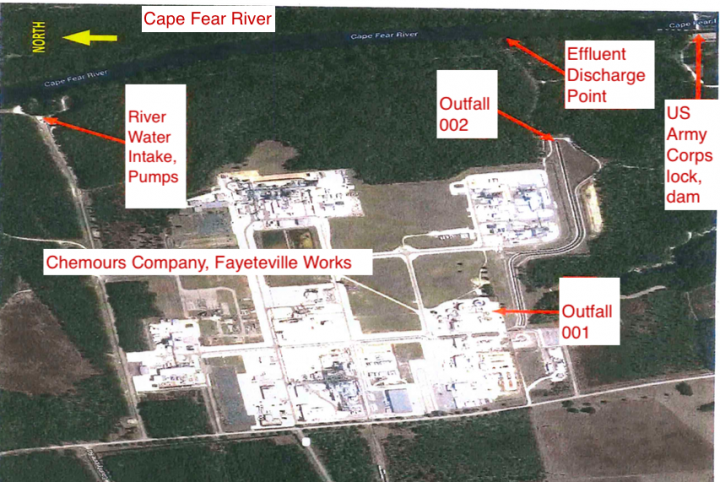
Reprinted from North Carolina Health News
Although extremely serious on its own, contamination by the industrial chemical GenX in the Cape Fear River is significant beyond potential risks to the public drinking water downstream.
Supporter Spotlight
Public scrutiny of how the industrial chemical got there in the first place is raising awareness of scientific concerns about potential hazards from unregulated GenX and similar compounds. It is also bringing new attention to how well multiple government agencies and industry, in this case Dupont and its spinoff Chemours, protect people from potential risks.
GenX is one of many human-made compounds called per- and polyfluoroalkyl substances, or PFASs. While not household names, PFASs make up a category of super-tough substances used in many common products that consumers love, including non-stick cooking pans, stain resistant carpets, waterproof clothing and food packing.
But that toughness has a downside: the chemicals stick around rather than degrade quickly once released into the environment.

U.S. companies voluntarily stopped using an older generation of PFASs, including the compound PFOA (also known as C8). Research has shown associations between exposure to some older generation PFASs and several health problems, including increases in cholesterol levels, thyroid and liver disease, pregnancy related high blood pressure (known as pre-eclampsia) and other ailments, said East Carolina University toxicologist Jamie DeWitt, who has studied GenX.
Chemours for years has heralded GenX as an improved substitute for PFOA and similar substances due to differences in its chemical structures which it was anticipated would make it less persistent in the environment, thus reducing any potential health risks. But some scientists are finding reasons to be concerned.
Supporter Spotlight
Chemours Co., a DuPont spinoff, repeatedly has said levels of GenX released since possibly the 1980s from its Fayetteville Works plant, upstream from Wilmington and other communities, are at levels that pose no health hazards.
In that context, persistent and big questions regarding GenX pollution in Cape Fear remain extremely important, including:
- For how long did DuPont and Chemours, the spinoff, release GenX and similar compounds?
- Have people been harmed by drinking water tainted by chemicals that they did not know tainted their water?
- Did DuPont or Chemours violate state or federal laws when releasing GenX upstream of drinking water intakes in Wilmington and nearby communities?
- Did government agencies, from the local to the federal, do all they should have to prevent the pollution?
That final question is developing political overtones in the state capitol. Republican senators recently announced a legislative hearing to question Democratic Gov. Roy Cooper’s administration regarding “inconsistencies” in its response to the discharge of GenX and how money he’s requesting “would be used to meaningfully improve water quality and public safety in the lower Cape Fear region.”
Cooper, as part of a plan to better research and monitor GenX and many other unregulated pollutants of concern in this state’s rivers, has asked the legislature for $2.58 million in funding. When he made the requests, Cooper noted that legislative budget cuts in recent years resulted in the loss of 70 positions within the state Department of Environmental Quality. Those cuts included eliminating staff available for permitting, compliance and enforcement programs.
The emerging political conflict is not sitting well with some people on the receiving end of that water in Wilmington, where GenX has been detected in drinking water, including former Mayor Harper Peterson, a Democrat active in the group Clean Cape Fear. That alliance of local groups hosted a community non-partisan forum on GenX last month.
“Let’s come with an agenda that focuses on action and address the issue: the risk of unsafe drinking water. Leave your party affiliation at the door,” Peterson said.
To keep up as this story unfolds, it’s useful to know its history, particularly what’s listed in the timeline below.
1980s: According to notes taken at a meeting with Chemours staff, the Fayetteville Works facility has produced and discharged substances identified now as GenX since the 1980s.
2002: DuPont starts producing PFOA, also known as C8, in North Carolina, at its Fayetteville Works property adjacent to the Cape Fear River on the border of Cumberland and Bladen counties. This information is according to a Securities and Exchange Commission document filed by an activist DuPont shareholder.
2004: EPA charges DuPont with violating the Toxic Substances Control Act due to multiple failures from 1981 onwards to report evidence of human health risks from PFOA in Ohio and West Virginia. Cited was evidence that a female employee had transferred the chemical to her developing fetus and confirmation of contamination of public water supplies in West Virginia and Ohio.
2005: DuPont agreed to pay $10.25 million, EPA’s largest civil administrative penalty at that time, to settle PFOA charges. It also agreed to commit another $6.25 million, partly to pay for research assessing if other DuPont products break down to form PFOA, which could result in widespread contamination.
2009: DuPont, which commits to not making, buying or using PFOA by 2015, is deploying GenX to create high-performance fluoropolymers, according to company marketing materials. EPA, in a consent agreement, requires the company to prevent GenX from escaping from any manufacturing processes with “99 percent efficiency.”
2015: A research paper is published showing that EPA scientists and collaborators, using chemical detective work, detected GenX and other newer generation PFAS compounds in the Cape Fear River.
2016: Research by Harvard scientists disclose that EPA-mandated sampling detected PFASs in public drinking-water supplies for 6 million people between 2012 and 2015. Most of those samples were collected near manufacturing facilities and other sites where they are used. North Carolina ranks third nationwide for the number of detections.
2016: A research publication by N.C. State University water chemist Detlef Knappe and others report finding GenX in untreated drinking water drawn from the Cape Fear River. The paper also notes the compound’s resistance to standard water cleaning treatments. Knappe had notified state and water utility officials of the finding before publication.

January 2017: A publication by ECU toxicologist Jamie DeWitt shows that in lab mice GenX appears to leave a body sooner and may be less potent than PFOA. That said, the chemical did generate some of the same physiological changes observed in lab studies after exposure to older generation PFAS compounds, although at lower concentrations.
June 2017: The Wilmington StarNews reports that GenX, which is unregulated, was detected but local utilities and the state, alerted to the problem by Knappe, did not publicize the findings. Residents in Wilmington and nearby towns criticize local, state and federal officials for not acting sooner.
June 2017: Chemours staff, in a closed-door meeting, tell state and local utility officials that GenX’s release, which took multiple attempts to stop, originated from a process at Fayetteville Works exempt from the EPA consent order. They also reveal that releases likely started in the 1980s. Company representatives maintain that levels released are too low to pose a hazard.
July 2017: Multiple investigations are launched:
- EPA starts investigating whether Chemours complied with the 2009 Toxic Substances Control Act consent order. Failure to do so usually results in civil and criminal penalties. The federal agency also starts assessing if changes to the consent agreement are needed.
- Federal prosecutors subpoena documents, research and monitoring data from DEQ as part of a grand jury probe.
- Attorney General Josh Stein launches a civil investigation into Chemours marketing practices regarding its representation about GenX’s safety.
- Cooper directs the State Bureau of Investigation to assess whether a criminal probe might be needed to determine if Chemours violated North Carolina law forbidding intentional violations of the U.S. Clean Water Act, or violations of the EPA consent order.
July 2017: The state Department of Health and Human Services lowered by 99.8 percent a provisional “health goal” limit for GenX amounts in drinking water, reducing it from 70,000 parts per trillion to 140 ppt. The number is a provisional estimate built with limited data of the contamination level below which exposure is unlikely to do harm to people, including developing fetuses and bottle-fed babies over a lifetime of exposure.
August 2017: Cape Fear Public Utility Authority attorneys announce plans to sue Chemours and DuPont in federal court to enforce federal Clean Water Act requirements due to the pollution.
August 2017: In a press release, Republican senators announce a plan to stage a legislative hearing regarding “inconsistencies” in the Cooper administration’s handling of GenX pollution.

August 2017: In response, DEQ Secretary Michael Regan and Health and Human Services Secretary Mandy Cohen said they are ready and willing to cooperate fully. They note that in May or June 2016 the administration of former Republican Gov. Pat McCrory received information about EPA and N.C. State University research on GenX in the Cape Fear.
The letter also posed its own criticism. “We should also warn that the General Assembly is poised to eliminate a provision in G.S. 150B-19.3 that restricts regulators’ ability to address threats to public health, safety and welfare.” The text links to a conference report for House Bill 162 which was not published, but circulated to legislators, state officials and reporters.
August 2017: A group of N.C. State and ECU researchers are applying for National Institutes of Environmental Health Sciences funding to test for PFASs levels in blood and urine of people living in the Cape Fear River basin.
This story is provided courtesy of North Carolina Health News, a website covering health and environmental news in North Carolina. Coastal Review Online is partnering with North Carolina Health News to provide readers with more environmental and lifestyle stories of interest about our coast. You can read other stories about health care here.






